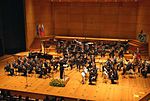Tivoli Pond
1880 worksGeography of LjubljanaPages containing links to subscription-only contentPonds of SloveniaTivoli City Park

Tivoli Pond (Slovene: Tivolski ribnik, less often Tivolski bajer or simply Tivoli or Ribnjak ('pond')) is a man-made pond at the southeastern end of Tivoli City Park in Ljubljana, the capital of Slovenia. It was created in 1880. It is part of Tivoli–Rožnik Hill–Šiška Hill Landscape Park and has been used for recreation, fishing, and as a flood-control reservoir. The pond is administered by the Barje Fishing Club. It has been home to a variety of native and non-native animal species and it has served as a theme and a scene for visual artists and musicians.
Excerpt from the Wikipedia article Tivoli Pond (License: CC BY-SA 3.0, Authors, Images).Tivoli Pond
Cesta 27. aprila, Ljubljana Rožna dolina
Geographical coordinates (GPS) Address Nearby Places Show on map
Geographical coordinates (GPS)
| Latitude | Longitude |
|---|---|
| N 46.052155555556 ° | E 14.494602777778 ° |
Address
Ribe
Cesta 27. aprila
1102 Ljubljana, Rožna dolina
Slovenia
Open on Google Maps






